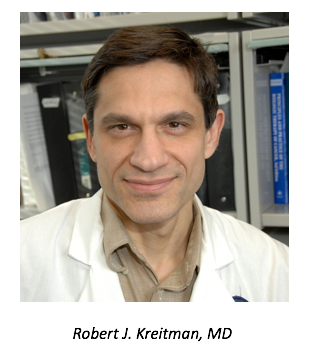Article
Robert J. Kreitman, MD, on New Kind of Treatment for Hairy Cell Leukemia
Author(s):
Robert J. Kreitman, MD, discusses the FDA’s recent approval of moxetumomab pasudotox (Lumoxiti) for the treatment of hairy cell leukemia (HCL).

This month, the US Food and Drug Administration (FDA) approved the first new treatment option for hairy cell leukemia (HCL) in over 20 years—AstraZeneca’s moxetumomab pasudotox (Lumoxiti), a new kind of treatment developed to fulfill an unmet need for patients with the rare blood cancer whose disease has progressed after trying other approved therapies.
In an exclusive interview with Rare Disease Report® (RDR®), Robert J. Kreitman, MD, lead investigator on the drug’s phase 3 clinical trial, provided insight on what makes the CD22-directed cytotoxin so unique as well as the clinical implications of its approval.
RDR®: Can you discuss Lumoxiti? What makes the treatment unique?
Dr. Kreitman: It’s an idea that goes back several decades—taking an antibody or part of an antibody and partnering it with a toxin so that the antibody will bind to a target on the cancer cell, go inside, and then the toxin [will] kill the cell. In Lumoxiti, the toxin comes from Pseudomonas aeruginosa bacteria—it’s a very powerful toxin.
Can you discuss the phase 3 trial of Lumoxiti?
We had a preliminary meeting with the FDA back in 2012 where we planned out what we needed to achieve in order to have the drug approved. We knew back then that it had good activity, but we received good feedback from the FDA about what kind of trial would be acceptable to design.
We designed a trial where everyone who entered into the trial would receive Lumoxiti at a fixed dosing level. We decided we would observe the treated patients for toxicity and efficacy, and if they achieved a certain complete remission rate that was durable enough. In other words, we observed whether the patient had improved blood counts for at least 6 months—that counted towards what we called the primary endpoint.
We met the primary endpoint, and the FDA, therefore, approved the drug.
What were trial’s key findings?
The important findings were twofold. [Lumoxiti] was able to achieve complete remission that was durable, and it was well tolerated in that the toxicity we saw was reversible; it was also acceptable toxicity.
Going further, the toxicities that we expected were not the kind of toxicities that you would see from chemotherapies because this agent is more of a biologic immunotherapy—it’s not a chemotherapy. We did not see the kind of toxicities that you would see from chemotherapies that would harm the immune system and leave patients open to infections.
The other thing we found was, not only did we achieve complete remission, but most of the complete remissions had no minimal residual disease, which represents traces of hairy cells that are left over after complete remission. We found that when you get rid of the minimal residual disease, then the complete remissions last longer.
Most of the patients with complete remissions had removal of the residual disease. We found that was also a significant finding.
Were there any notable challenges that you encountered in the trial? How did you overcome them?
The 2 most important toxicities that we saw were ones that we predicted from the early studies—the phase 1 trial and studies that were done before that. We expected to see capillary leak syndrome (CLS). Fortunately, we found that as long as we encouraged patents to drink plenty of fluids, we did not see really any CLS to the point where it was a major problem with the trial.
The other toxicity is called hemolytic uremic syndrome (HUS). They are somewhat related in that HUS is a syndrome of low platelets and low kidney function that also resolves on its own after stopping the drug. We found that making sure patients drink plenty of oral fluids—which is the simplest way to hydrate a patient—seemed to do well.
Some of the patients needed low doses of steroids—that also blocks some of the toxicities. By doing these maneuvers, we found that these toxicities could be minimized.
What are the clinical implications of this approval?
This is another option for patients who had at least 2 prior therapies. It’s 1 where the patient will have to be treated intravenously. It’s not an oral treatment, but it is 1 that offers a long period of time after achievement of complete remission where the patient can stay in complete remission [for] many years, and this is what we’ve seen in the clinical trials.
What are next steps for Lumoxiti?
We are interested in studying combinations of Lumoxiti; these trials are not yet opened, but we’re working on them as we speak.





